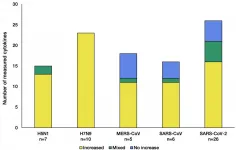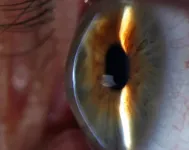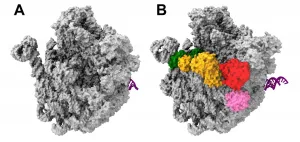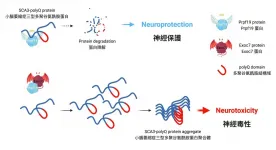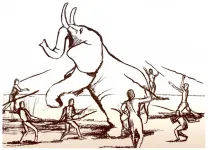(Press-News.org) Respiratory viruses such as SARS-CoV-2 (causing COVID-19) can often catalyse an overactive immune response that leads to a life-threatening cycle, known as a cytokine storm. Analysing cytokine responses from patients infected with SARS-CoV-2 and similar common respiratory viruses has unearthed glaringly important differences in how SARS-CoV-2 affects cytokines compared to other common respiratory viruses.
The comprehensive data resource aims to help specialists identify better treatments and diagnosis of underlying causes that can cause the deadly cytokine storm.
Scientists at the Earlham Institute (EI) and the Quadram Institute study how the immune system responds to infection with SARS-CoV-2 and other similar respiratory viruses, in particular to identifying unique features in severely ill COVID-19 patients.
Members of the Korcsmaros Group working alongside the clinical virologist Claire Shannon-Lowe at the University of Birmingham, focused their attention on how SARS-CoV-2 and other respiratory viruses are causing the so-called 'cytokine storm' - a hyper-activation of our own immune system - one of the main reasons for the high death rate in subgroup of COVID-19 patients.
To identify the similarities and differences in the cytokine storm, the researchers collected and analysed the vast collection of thousands COVID-19 research papers. They looked for patterns of cytokine changes in patients who had been infected by respiratory viruses that cause cytokine release syndrome.
By systematically analysing over 5,000 scientific studies to find those containing immune response data from patients, the researchers showed that SARS-CoV-2 has a unique tendency of halting the rise of specific cytokines in certain patients, when compared to other similar viruses. This is important in understanding the causes of the potentially fatal cytokine release syndrome, more commonly known as a cytokine storm.
"As the onset of the cytokine storm is one of the key factors behind the mortality rates we're seeing in a particular group of COVID-19 patients, it is critical to understand why it is happening" said project lead PhD Student Marton Olbei in the Korcsmáros Group.
"Cytokine storms are not unique to SARS-CoV-2 infection; they can be found in most of the critical human coronaviruses and influenza. A subtype outbreaks of the past two decades."
Cytokines are small proteins that tightly regulate our immune system and how our body reacts to internal or external stress, such as cancer, inflammation, or infection. Cytokines act as conductors, orchestrating our immune response when infected with viruses. One of their roles is to cause inflammation, which is part of the healing process of many infections and injuries.
Respiratory viruses all activate antiviral responses in the body but there are differences in how each virus attempts to evade the attention of the immune system. The most common strategy is to confuse, or specifically attack, crucial immune response mechanisms - such as the release of cytokines.
A cytokine storm happens only in certain patients' immune systems when reacting to a virus. A feedback loop causes the continual activation of cytokines responsible for inflammation, resulting in organ failure or even death.
While SARS-CoV-2 cases have distinct similarities to both influenza patients and those who were infected in previous coronavirus outbreaks (SARS-CoV, MERS-CoV), the researchers' analysis found specific immune mechanisms that make SARS-CoV-2 uniquely dangerous.
"We examined the changing cytokine levels upon infection with similar viral pathogens (SARS-CoV, MERS-CoV, H5N1, H7N9) to highlight the protective and unique cytokine responses caused by these viruses," said Marton.
By comparing the COVID-19 patients' immune response data, the researchers found similarities mounted against these pathogens - discriminating between influenza A subtypes and coronaviruses - and the unusual aspects of the current circulating SARS-CoV-2 virus.
SARS-CoV-2 is similar to other respiratory viruses but, by targeting specific regulators of the cytokine response, with just small-scale differences, it could lead to a more severe disease - not from the virus itself, but from the patient's immune system response.
"For a subgroup of patients, when infected by these viruses, a real danger is posed by the immune system overreacting. We're drawing out which specific parts of our immune system react in a potentially harmful way to these viruses, said Marton.
"We wanted to take a step back and summarise what is actually being reported in the scientific literature, specifically focusing on cytokine-mediated immune responses, to put into context and differentiate SARS-CoV-2 from these other viruses. Building up a data repository such as this will also be vital for the future; if other similar viruses arose, you could quickly find their profile and compare."
A map of such immune responses could help clinical specialists identify interventions that have successfully alleviated cytokine storm in other diseases, and evaluate whether they could be effective in treating certain COVID-19 cases.
INFORMATION:
The paper 'SARS-CoV-2 causes a different cytokine response compared to other cytokine storm-causing respiratory viruses in severely ill patients' is published in Frontiers in Immunology.
In order to avoid the occurrence of such effects, the Federal Institute for Health Protection of Consumers and Veterinary Medicine (BgVV) recommended guidance values for maximum THC levels in various food groups in 2000. The guidance value for beverages was given as 0.005 mg/kg, for edible oils with 5 mg/kg and for all other foods with 0.150 mg/kg. In 2018, the BfR came to the conclusion that these values no longer correspond to current scientific knowledge.
Instead, the BfR recommends that the toxicological assessment of hemp-containing foods be carried out on the basis of the acute reference dose (ARfD) of 1 microgram Δ-THC/kg body-weight derived by the European Food Safety Authority (EFSA) in 2015. The ARfD specifies the estimated maximum quantity ...
DNA nanotechnology - the research field using DNA molecules as building material - has developed rapidly during recent years and enabled the construction of increasingly complex nanostructures. DNA nanostructures, such as DNA origami, serve as an excellent foundation for nanocarrier-based drug delivery applications, and examples of their use in medical treatments have already been demonstrated. Although the stability of such DNA nanostructures under physiological conditions can be improved, little is known about their digestion by endonucleases, which, found everywhere in our blood and tissues, are responsible for destroying foreign DNA in our bodies.
To tackle this emerging question, a ...
Scientists have taken a significant step forward in their search for the origin of a progressive eye condition which causes sight loss and can lead to corneal transplant.
A new study into keratoconus by an international team of researchers, including a University of Leeds group led by Chris Inglehearn, Professor of Molecular Ophthalmology in the School of Medicine, has for the first time detected DNA variations which could provide clues as to how the disease develops.
Keratoconus causes the cornea, which is?the clear outer layer?at the front of the eye, to thin and bulge outwards into a cone shape over time, resulting in blurred vision and sometimes blindness. It usually emerges in young adulthood, often with lifelong ...
Researchers are in the search for generalisable rules and patterns in nature. Biogeographer Julia Kemppinen together with her colleagues tested if plant functional traits show similar patterns along microclimatic gradients across far-apart regions from the high-Arctic Svalbard to the sub-Antarctic Marion Island. Kemppinen and her colleagues found surprisingly identical patterns.
It is widely known that global vegetation patterns and plant properties follow major differences in climate. Yet, it has remained a mystery how well the same rules can be applied at very local scales. Are responses to the environment similar in plant communities ...
Ribosome formation is viewed as a promising potential target for new antibacterial agents. Researchers from Charité - Universitätsmedizin Berlin have gained new insights into this multifaceted process. The formation of ribosomal components involves multiple helper proteins which, much like instruments in an orchestra, interact in a coordinated way. One of these helper proteins - protein ObgE - acts as the conductor, guiding the entire process. The research, which produced the first-ever image-based reconstruction of this process, has been published in Molecular Cell*.
Ribosomes are an essential component of all living cells. Frequently referred to as 'molecular protein factories', they translate genetic information into chains of linked-up ...
What can you see on this picture (next to thearticle)? Say what comes to your mind immediately!
If you said „star", you focus rather on the details, if you said „sun", then rather on the global pattern.
People can be different in whether they typically see the forest or the trees, but the dominant attentional mode is focusing first on the whole, and then on the details. This is the same with children. Or so it has been until now! Children of the Alpha Generation (who has been born after 2010) typically grow up with mobile devices in their hands which seems to change how they perceive the world, as Hungarian researchers showed.
The Alpha Generation Lab of Diagnostics and Therapy Excellence Programme at Eötvös Loránd University (Budapest) studies ...
Materials - Quantum building blocks
Oak Ridge National Laboratory scientists demonstrated that an electron microscope can be used to selectively remove carbon atoms from graphene's atomically thin lattice and stitch transition-metal dopant atoms in their place.
This method could open the door to making quantum building blocks that can interact to produce exotic electronic, magnetic and topological properties.
This is the first precision positioning of transition-metal dopants in graphene. The produced graphene-dopant complexes can exhibit atomic-like behavior, inducing desired properties in the graphene.
"What could ...
Collaborating with the University of Oxford, Professor Ho Yin Edwin Chan's research team from the School of Life Sciences of The Chinese University of Hong Kong (CUHK) recently unveiled the counteracting relationship between pre-mRNA-processing factor 19 (Prpf19) and exocyst complex component 7 (Exoc7) in controlling the degradation of disease protein and neurodegeneration of the rare hereditary ataxia. The research findings have been published in the prestigious scientific journal, Cell Death & Disease.
Protein misfolding contributes to the pathogenesis of SCA3
Proteins play a significant role in every single cell development in the human body, including neurons. Numerous studies have proved that misfolds and aggregation of ...
A new paper by Dr. Miki Ben-Dor and Prof. Ran Barkai from the Jacob M. Alkow Department of Archaeology at Tel Aviv University proposes an original unifying explanation for the physiological, behavioral and cultural evolution of the human species, from its first appearance about two million years ago, to the agricultural revolution (around 10,000 BCE). According to the paper, humans developed as hunters of large animals, causing their ultimate extinction. As they adapted to hunting small, swift prey animals, humans developed higher cognitive abilities, evidenced by the most obvious evolutionary change - the growth of brain volume from ...
A study carried out by researchers from the Institute of Genomics, University of Tartu revealed that human gut microbiome can be used to predict changes in Type 2 diabetes related glucose regulation up to four years ahead.
Type 2 diabetes is a metabolic disease characterized by elevated blood glucose levels that contributes to millions of deaths worldwide each year and its prevalence is rapidly increasing. Type 2 diabetes is preceded by "prediabetes" - a condition when the glucose levels have started to rise, but the progression of the disease ...
